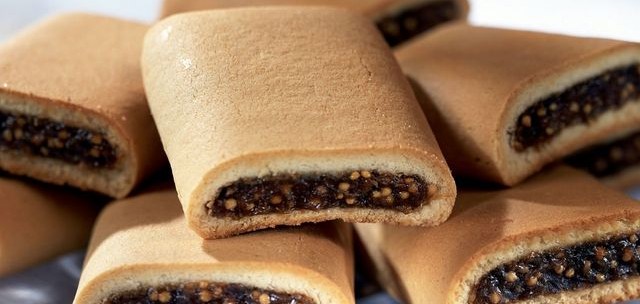If you are like me, you spend time analyzing your favorite store bought foods and try to figure out how to make them yourself. Today I will share a recipe for for one of my favorites: Fig Newtons.
Homemade Fig Newtons
Yield: Approx 20 cookies
Active Time: 1 hour
Total Time: 4 hours
Fig Newton Ingredients:
Dough:
- 8 ounces all purpose flour
4 ounces unsalted butter, room temperature
3 1/2 ounces sugar
1 ounce honey or corn syrup
1/4 teaspoon baking soda
1/4 teaspoon salt
2 teaspoons vanilla extract
1/8 teaspoon cinnamon
1 teaspoon orange zest
3 egg yolks
1 ounce orange juice
Filling:
- 12 ounces dried black Mission figs
2 ounces unsweetened applesauce
1 1/2 ounces honey or corn syrup
1/4 teaspoon cinnamon
Directions:
Make the fig newtons Dough:
- Sift flour and set aside. Using a mixer, cream the butter along with the sugar, honey or corn syrup, baking soda, vanilla, cinnamon, and orange zest on medium speed until the mixture is light and fluffy. Scrape bowl down with spatula, and continue mixing. Add the egg yolks one at a time, mixing thoroughly.
- Mixer on low and add the sifted flour all at once. Drizzle orange juice. Continue mixing until just homogenous.
- Shut off the mixer. The dough will be very soft and wet.
- Prepare a large sheet of plastic wrap and use a rubber spatula to transfer the dough from the bowl to the center of the plastic. Fold the plastic over the dough and flatten into a disc. Wrap with remaining plastic and refrigerate for four hours or overnight.
Make the filling:
- Combine the figs, applesauce, honey or corn syrup and cinnamon in the bowl of a food processor. Pulse until smooth. Scrape the bowl down with a rubber spatula and pulse again to ensure to chunks remain; if any sneak by, they will clog the pastry tip during piping.
- Use a rubber spatula to transfer the fig paste to a pastry bag fitted with a large, plain basket weave tip. Alternately, use a heavy duty zip-top bag with a corner snipped off.
- Set the filling aside until needed.
Making the cookies:
- Preheat the oven to 325°F and have a parchment lined cookie sheet ready.
- Even after chilling, the dough will be significantly softer than the typical rolled dough. Dust the rolling surface heavily with sifted flour to prevent sticking, and dust the surface of the dough as well. With a pin, roll the dough to 1/4″ thickness. Frequently lift and move the dough, redusting if needed, to ensure it does not stick. If any places do stick, slide an offset metal spatula between the dough and the counter to loosen and dust the affected area with more flour.
- Use a ruler and a pizza cutter to cut the dough into several 3 1/4″ wide strips. It is easiest to handle the dough if these strips are no longer than 6″ so if you find your strips are particularly long, you may want to cut them into more manageable lengths. If the dough is heavily covered in flour, gently dust in clean with a dry pastry brush.
- Pipe a strip of fig filling down the center of each dough strip; you want the filling to be 1″ wide and about 1/4″ thick, feel free to pipe a thicker or thinner filling to suit your own tastes. If you’re piping with a plastic bag without a tip, after you’ve distributed the filling, use a dampened finger to pat the filling down into a flat, rectangular strip.
- To make the Newton bars, lift one of the long, exposed dough strips up and over filling. If you have trouble lifting the dough with your fingers, you can use an offset spatula. Take a hold of the folded side of the cookie-bar and roll it over the remaining flap of dough. Repeat with remaining cookie bars. The dough will be doubled where the two strips overlap on the bottom; this gives the Newtons their characteristically bowed shape. You can use your hands to pat the bars down on their long sides to emphasize this shape if you like.
- Use a dry pastry brush to dust off any excess flour from the cookies. Transfer the bars to the prepared cookie sheet. Bake for approximately 12 minutes or until the cookies have puffed and lightly browned. They will be just slightly firm to the touch; if they feel puffy or moist, continue baking a few more minutes.
Cutting and aging your fig newtons:
As soon as the cookies are removed from the oven, use a sharp knife to trim each bar into several 1″ long cookies. While the cookies are still warm, transfer them to a plastic container with a lid or large zip-top bag. If you need to stack the cookies, place a piece of parchment between the layers. Seal the container or bag tightly.
This step will slightly steam the cookies, ensuring they will remain soft and cake-like from end to end. Skipping this step will result in Newtons with a slightly drier texture, more like a cookie and less like cake.
The fig newtons will keep, at room temperature, for about two weeks.
Let us know what you think of this fig newton recipe in the comment section below or on social media Facebook



